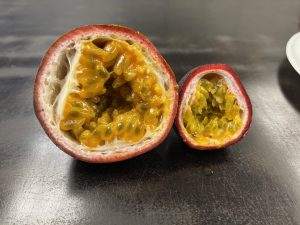
With passion fruit, you get more than just a tasty drink or snack. It is packed with nutrients like vitamin C, fiber and antioxidants, making it a popular choice for healthier eating.
Understanding how varieties of passion fruit stay fresh after they are harvested can help reduce waste, improve nutrition and make sure consumers enjoy the fruit and its health benefits, said Tie Liu, an associate professor of horticultural sciences at the University of Florida Institute of Food and Agricultural Sciences (UF/IFAS).
Published Research
Liu led a newly published study in which he and his colleagues wanted to know why some varieties of passion fruit stay fresh longer than others.
In the study, scientists examined three kinds of passion fruit and used special lab processes – called metabolomics — to measure natural chemicals like sugars, acids and flavors, inside their juice.

“These tools help us see what’s in the fruit on a tiny scale by measuring hundreds of different natural chemicals that affect how the fruit tastes, smells, its nutrition level and how long it stays fresh,” Liu said.
Researchers found that one variety, called Passiflora ligularis – or orange passion fruit — stayed fresh the longest. It also had low acidity, more vitamin C and flavonoids, all of which help protect the fruit from spoiling.
While orange passion fruit grows mainly in South America, purple passion fruit — also known as Passiflora edulis — grows widely in Florida. It contains more fruity esters, which make it more flavorful.
Aiding Breeders
Now that scientists have identified genetic and biochemical markers associated with passion fruit deterioration, researchers can now help breeders select firmer varieties that better resist shriveling, Liu said.
Specifically, by collaborating with Ali Sarkhosh — a leading passion fruit researcher with UF/IFAS and a co-author of the paper — and by incorporating metabolomics insights, plant breeders can develop healthier passion fruit varieties that taste better and stay fresher longer after harvest. All of this ultimately improves their market value and shelf life, Liu said.
“That means less fruit goes to waste, you get more value, and you get a tastier fruit for your family to enjoy,” he said. “Appearance, texture and flavor at the time of purchase are key for consumers. Our study helps define the biochemical and physical features that translate to consumer-perceived freshness and quality.”
Liu received significant help on the study from Yu Wang, an associate professor of food science and human nutrition at the UF/IFAS Citrus Research and Education Center in Lake Alfred. Wang studied the chemical profiles of the passion fruit varieties. Specifically, her lab focused on identifying and quantifying the metabolites to help characterize taste.
“Flavor-wise, passion fruit stands out with its distinctly tropical aroma — bright and vibrant, with strong sweet notes, hints of stone fruit, like peach or apricot and that unique tropical complexity that’s made it increasingly popular among consumers,” Wang said.









